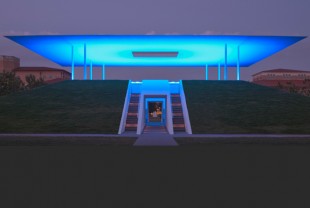Reservations will soon be accepted for the June 14 public opening of the James Turrell “Twilight Epiphany” Skyspace at Rice University. Houstonians who want to experience the sunset light show that evening can request tickets online at skyspace.rice.edu. Tickets are free, but the limit is two per person.
The June 14 event will begin at 7:30 p.m. with brief remarks by Rice University Art Director Molly Hubbard; Jonathon Glus, CEO of the Houston Arts Alliance; Raymond Brochstein, chair of the Rice Art Committee; and Rice trustee and alumna Suzanne Deal Booth, whose gift made it possible for the university to commission acclaimed American artist James Turrell to design the skyspace and to build it. Parking will be free for the public opening.

The James Turrell "Twilight Epiphany" Skyspace will open to the public June 14 with a sunset light show.
The skyspace can seat up to 120 people, with 44 in the lower viewing area, which is wheelchair-accessible, and 76 in the upper viewing area. Houstonians who are unable to reserve tickets to view the June 14 sunset light show inside the skyspace have the option of sitting on chairs that will placed outside the structure just for this event, or they can reserve tickets for another date.
During the summer, the skyspace will be closed on Tuesdays for private events but will be open to the public throughout the rest of the week. Two light shows will be held daily. The morning light show begins 40 minutes before sunrise, and the evening light show begins at sunset. The skyspace is closed overnight. The calendar at skyspace.rice.edu shows the time of sunrise and sunset for each date and includes notices about when the skyspace will be closed to the public. Because a large demand is initially expected for the sunset light shows, tickets must be reserved for those times.
The pyramid-like Turrell Skyspace towers above a 12-foot-high grass berm just east of Rice’s Shepherd School of Music. Visitors seated on the skyspace’s lower and upper viewing areas can gaze up at the 72-by-72-foot white roof, which offers a view of the sky through a 14-by-14-foot opening. Lights projected on the ceiling will change colors as the sun rises and sets, and these will impact the color of the sky as seen by visitors. Although the color changes on the ceiling can be viewed from outside the skyspace, the magical color changes of the sky through the opening in the ceiling can be experienced only from inside the structure.
Thomas Phifer and Partners served as the architect for the skyspace, and Linbeck was the contractor. The roof is a composition of several specifically engineered materials with a carbon-steel knife edge. The seating area on the lower level is made of pink and gray Texas granite from Marble Falls; on the upper level, poured-concrete benches provide seating. A sequence of LED lights installed in the upper level is programmed to create the light show on the ceiling in sync with sunset and sunrise. The show lasts about 40 minutes, and the light program can operate in a variety of weather conditions.
Rice has the first Turrell skyspace to be engineered for acoustics. Twelve state-of-the-art speakers are “hidden” in the plaster walls. Although music will not be played during the sunset and sunrise light shows, Turrell is creating additional light shows for use by the Shepherd School for live performances as well as for use by students who participate in the Rice Electroacoustic Music Labs.
Over the past four decades, Turrell has created skyspaces in 25 countries. The skyspace at Rice is his 73rd and one of the largest. “Each is unique,” he said. “I wanted this one to feel open because it’s a very public space and at the same time it’s an enclosure.”
Turrell said the relation of inside to outside is very important. “This is one in which you will see the sky be almost any color you like, in fact, quite some surprising tones,” he said. “If you take a photo of the sky in this skyspace, the color you see in the opening is not actually going to show up in your camera because in fact it is not there.
“This is a gentle reminder that because we give the sky its color and can then change the color of the sky, we create the reality in which we live. The light that we make is something that changes the reality of how we perceive the sky. We do create the world in which we live to a much larger extent than we are willing to take responsibility for.”
For more information on public art at Rice, visit publicart.rice.edu.
For a map of the campus, visit http://www.rice.edu/maps/maps.html. The closest public parking lots to the skyspace are in the underground garage at McNair Hall and in the visitor lots west of Alice Pratt Brown Hall.


This new space is incredible for all the senses. I can’t wait for the opening — Frances Davidson ’90